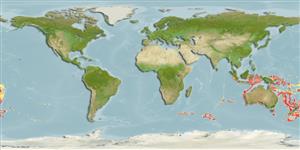>
Gadiformes (Cods) >
Bathygadidae (Rattails)
Etymology: Gadomus: Latin, gadus = a fish, cod? (Ref. 45335); pepperi: Named for Roger Pepper, fishing master of FRV Southern Surveyor and FRV Soela..
More on authors: Iwamoto & Williams.
Environment: milieu / climate zone / depth range / distribution range
Ecología
marino batidemersal; rango de profundidad 817 - 1500 m (Ref. 35909). Deep-water
Eastern Indian Ocean: southern Australia, from Western Australia, to Bass Strait, New South Wales and Queensland.
Tamaño / Peso / Age
Maturity: Lm ? range ? - ? cm
Max length : 38.0 cm TL macho / no sexado; (Ref. 35909)
Short description
Morfología | Morfometría
Espinas dorsales (total): 2. Narrow space separating the premaxillary dentigerous band (5.3-6.6% of premaxillary length); first dorsal fin with 9-10 soft rays; barbel less than three times orbit diameter, not extending beyond jaws. About 75 pyloric caeca. Remarks: second ray of first dorsal and upper ray of pectoral greatly extended; outer ray of pelvic fin extending well beyond anal origin; extended rays of pectoral slender.
A benthic species found on the continental slope (Ref. 75154).
Life cycle and mating behavior
Madurez | Reproducción | Puesta | Huevos | Fecundidad | Larva
Iwamoto, T. and A. Williams, 1999. Grenadiers (Pisces, Gadiformes) from the continental slope of western and northwestern Australia. Proc. Calif. Acad. Sci. 51(3):105-243. (Ref. 35909)
IUCN Red List Status (Ref. 130435)
Threat to humans
Harmless
Human uses
Más información
Nombres comunesSinónimosMetabolismoDespredadoresEcotoxicologíaReproducciónMadurezPuestaAgregación para la puestaFecundidadHuevosEgg development
Age/SizeCrecimientoLength-weightLength-lengthLength-frequenciesMorfometríaMorfologíaLarvaDinámica larvariaReclutamientoAbundanciaBRUVS
ReferenciasAcuiculturaPerfil de acuiculturaRazasGenéticaElectrophoresesheritabilidadEnfermedadesProcesamientoNutrientsMass conversion
ColaboradoresImágenesStamps, Coins Misc.SonidosCiguateraVelocidadTipo de nataciónSuperficie branquialOtolitosCerebrosVisión
Herramientas
Special reports
Download XML
Fuentes de Internet
Estimates based on models
Preferred temperature (Ref.
123201): 3.2 - 5.7, mean 4.6 °C (based on 222 cells).
Phylogenetic diversity index (Ref.
82804): PD
50 = 0.5001 [Uniqueness, from 0.5 = low to 2.0 = high].
Bayesian length-weight: a=0.00372 (0.00141 - 0.00980), b=3.11 (2.88 - 3.34), in cm total length, based on LWR estimates for this (Sub)family-body shape (Ref.
93245).
Nivel trófico (Ref.
69278): 3.1 ±0.1 se; based on size and trophs of closest relatives
Fishing Vulnerability (Ref.
59153): Low to moderate vulnerability (28 of 100).
